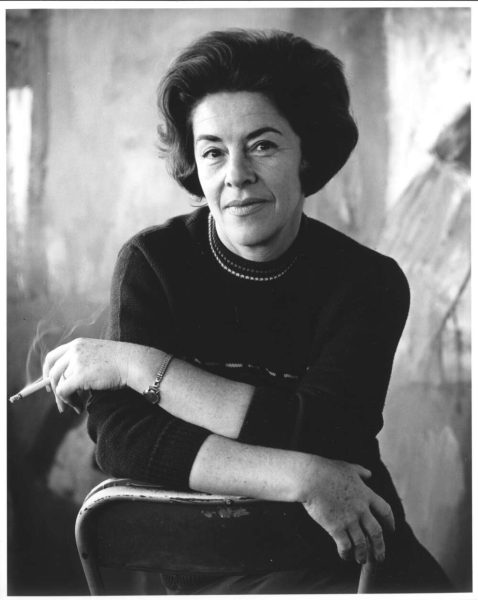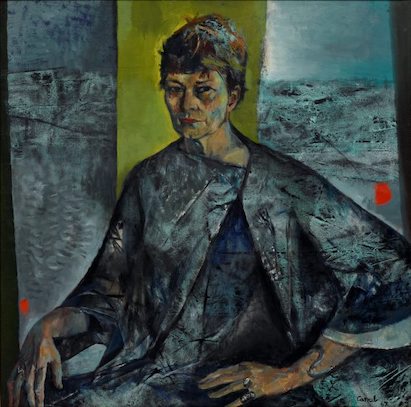Written by Elizabeth Heffernan, RAHS Volunteer
To celebrate Women’s History Month in 2021, the Royal Australian Historical Society will continue our work from previous years to highlight Australian women that have contributed to our history in various and meaningful ways. You can browse the women featured on our webpage, Women’s History Month.

PORTRAIT OF JUDY CASSAB, SYDNEY, SEPTEMBER 1964 BY G. HAWKSHAW. [IMAGE COURTESY NATIONAL LIBRARY OF AUSTRALIA, NLA.OBJ-140408422.]
Born Judit Kaszab in 1920 to Hungarian Jewish parents, Judy’s early life in interwar Europe was relatively unremarkable. She met her husband, Jancsi Kämpfner, in 1938 when she was 18 and he was 36. Already a talented artist, Judy attended the Academy of Art in Prague at Jancsi’s urging, who wanted her to pursue her career before committing to marriage. [1]
German occupation in 1939 cut Judy’s studies short. At the German embassy waiting for her travel papers, Judy felt for “the first time in my life that I was not a girl, not a woman, not a human being, but a Jew.” [2] Two years later, in 1941, Jancsi was sent to a forced labour camp. Judy travelled to Budapest for further study and, when the war caught up with her, assumed the identity of her Catholic maid Mária Koperdák. When Jancsi returned he went into hiding, and together they survived the war. They were the only members of their families to do so. [3]
Judy and Jancsi emigrated to Australia in 1951 with their two sons, Janos (John) and Peter. Their Australian life began in a Bondi boarding house with other Hungarian migrants – some of whom were Jewish, others Nazis. [4] Judy’s career took off soon after their arrival with her commissioned portrait of Sir Charles Lloyd Jones’ wife. The family moved to Woollahra where Judy began painting in earnest. She held her first solo exhibition in 1953, won back-to-back Women’s Weekly Portrait Prizes in 1955 and 1956, and became the second woman to win the Archibald in 1960 with her portrait of Stanislaus Rapotec. In 1967 she was the first woman to win the prize for a second time, an achievement she shares only with contemporary artist Del Kathryn Barton. [5]

PORTRAIT OF MARGO LEWERS, 1967. THIS WAS JUDY’S SECOND WINNING ARCHIBALD ENTRY. [IMAGE COURTESY ART GALLERY OF NSW, OA5.1968.]
Judy exhibited forty paintings in the Archibald throughout her career. She became a commander of the British Empire in 1969, and officer of the Order of Australia in 1988. She was the second female trustee of the Art Gallery of NSW in 1980, received an honorary doctorate from the University of Sydney, and earned Hungary’s Gold Cross of Merit in 2011. Judy died in Sydney in 2015, aged 95, fourteen years after the death of her husband. “If there is an afterlife,” Jancsi promised Judy the day before he died, “I shall love you there.” [7] Judy could not imagine her life without her art, and it is impossible to imagine the landscape of Australian art without Judy.
References:
[2] Cassab, ‘Documenting a Life’.
[3] ‘Judy Cassab – The Collection’, Art Gallery of NSW, https://www.artgallery.nsw.gov.au/collection/artists/cassab-judy/, accessed 23 February 2021; Cassab, ‘Documenting a Life’.
[4] Patricia Maunder, ‘Judy Cassab: Holocaust survivor, society darling and acclaimed portrait artist’, Sydney Morning Herald, 3 November 2015, https://www.smh.com.au/national/judy-cassab-holocaust-survivor-society-darling-and-acclaimed-portrait-artist-20151103-gkpd3s.html, accessed 23 February 2021.
[5] ‘Judy Cassab’, National Portrait Gallery; Maunder, ‘Judy Cassab’.
[6] ‘Judy Cassab’, AGNSW.
[7] ‘Judy Cassab’, AGNSW; ‘Judy Cassab’, National Portrait Gallery; Maunder, ‘Judy Cassab’.
